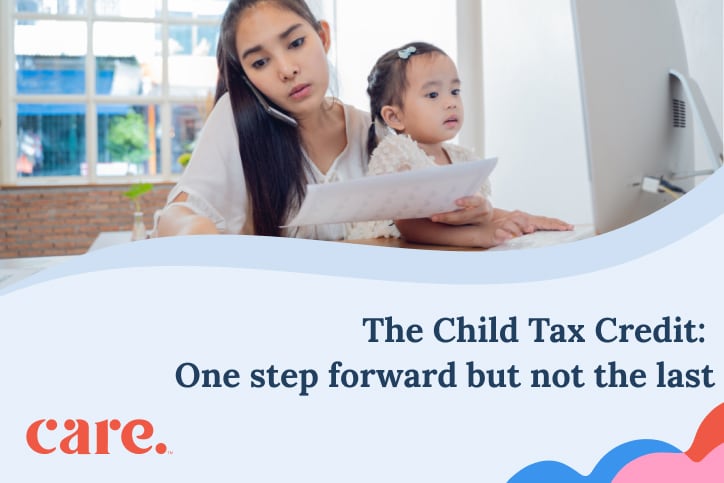When news of a potential expansion to the Child Tax Credit surfaced, it landed on the front page of many major media outlets, and for good reason. Child care costs continue to climb and parents are looking for whatever relief is available. Additionally, child care is one of the rare issues that truly has advocates on both sides of the aisle so there was significant reason to hope that the Tax Relief for American Families and Workers Act (Act) would have a real shot at passing. And, as someone who spends his days advocating for progress just like this, I (and my colleagues at Care) was gratified to see support for families finally front and center.
The Act, which as of this writing has passed the House by a wide margin but is still waiting for a vote on the Senate floor, is certainly a positive step forward, but it’s nowhere near enough. During the pandemic, expanding the Child Tax Credit to $3,600 (from $2,000) per child raised 2.1 million children above the poverty line. The expansion in the Act is notably smaller. Significantly so. Further, as child care expert Elliot Haspel recently stated in Fast Company, “child tax credits are not a child care policy, and this deal does nothing to change the need for major Congressional action on child care.”
He’s right. And the promising news is that, in addition to the Act, there are already a variety of bipartisan efforts on the table. Information is power, so the more parents know about these initiatives, the greater the likelihood that they gain traction.
Existing child care initiatives
Congressional Pre-K and Child Care Caucus
The Bipartisan Congressional Pre-K and Child Care Caucus is a forum to develop policy recommendations on and facilitate discussions about early childhood education and care. Research demonstrates that children who attend high quality child care and Pre-K programs exhibit improved academic performance and career outcomes later in life, which illustrates why the caucus is committed to prioritizing early education in Capitol Hill.
The caucus regularly hosts events for members of Congress and their families to learn about the significance of early childhood education and they engage in advocacy efforts urging action on pertinent topics.
Most recently, caucus leaders Suzanne Bonamici (D-OR), Ashley Hinson (R-IA), and Joaquin Castro (D-TX), addressed a letter to the House Ways and Means Committee while they were deliberating the Act, requesting further attention be paid to modernizing child care tax policies that would provide “immediate relief for working families and small businesses nationally”.
“When I was pregnant with my second baby, one of the first calls I made was to my child care provider to ensure they’d have a spot open once he was born. This isn’t an uncommon occurrence — improving access to affordable, quality child care is one of the top issues I hear about from Iowans, especially those in rural communities,” said Congresswoman Ashley Hinson when joining the caucus.
Joint statement: In support of tax relief for child care
Alongside 20 other national organizations brought together by the First Five Years Fund, Care.com signed a joint statement in support of the bipartisan collaboration that fueled a majority vote victory for the Act on the floor of the House of Representatives. The statement urged our Congressional Leaders to continue this work by considering the modernization of other existing tax policies – the Child and Dependent Care Tax Credit, the Dependent Care Assistance Program, and the Employer-Provided Child Care Tax Credit – all of which would support a family’s ability to afford child care.
These credits have the potential to have a meaningful impact but they have not been adjusted for inflation, rendering their caps inadequate to the current costs families incur. Moreover, they predominantly cater to very specific types of child care, such as center-based care. For the millions of families who rely on in-home care, the thousands of families living in a child care desert, and 65% of parents who have endured waitlists for daycare, this criteria further denies them any relief for the high costs.
By modernizing and expanding these credits, more parents would have meaningful dollars to put towards their child care expenses, ensuring they can remain in the workforce, thereby bolstering our economic prosperity.
Bill proposals for child care
In addition to these initiatives that leverage our existing tax policy, lawmakers have also introduced separate bills to improve the country’s child care infrastructure.
Child and Dependent Care Tax Credit Enhancement Act
As defined by the IRS, the Child and Dependent Care Tax Credit may help people pay for the care of eligible children or other dependents with the maximum credit amount being $1,050 for one person and $2,100 for two or more. As a part of the American Rescue Plan, these amounts were increased to $4,000 and $8,000 respectively. Senator Bob Casey (D-PA)’s office shared that in 2021, the temporary expansion of CDCTC resulted in the average tax credit per family quadrupling from $593 to $2,158.
In January 2024, Senator Casey introduced the Child and Dependent Care Tax Credit Enhancement Act (S. 3657) alongside Ron Wyden (D-OR), Chair of the Senate Finance Committee, and Patty Murray (D-WA), Chair of the Senate Appropriations Committee. This legislation seeks to put the CDCTC back to the expanded level seen during the pandemic and make those rates permanent. This bill calls for:
- Increasing the maximum amount families can obtain through the CDCTC to $4,000 per child; Automatically adjusting the credit to keep pace with inflation; and
- Expanding eligibility to low-income families by making the credit refundable.
“We must do everything in our power to put affordable child care within reach for every family, as we did when we expanded tax credits to help families pay for child care in 2021. Child care costs were too high for too many families well before the pandemic and that problem isn’t going away unless we take action to lower costs,” said Senator Casey in a press release. “It’s long past time to step up and make the child care tax credit available to everyone at the actual cost of child care today.”
“Not only is this tax credit an important financial boost for parents, it’s also a matter of economic fairness for workers. The sky-high cost of child care puts way too many American families in a position where Mom or Dad is forced to leave their job to take care of the kids,” said Senator Wyden. “That should be a choice people make because they want to, not because they need to for financial reasons. Senator Casey’s bill is about giving families more financial breathing room and more freedom to raise their kids and continue their careers in whatever manner they choose.”
Child Care Investment Act of 2023
The Child Care Investment Act of 2023 (H.R. 4571) was introduced by Representative Salud Carbajal (D-CA) and Representative Lori Chavez-DeRemer (R-OR) to address the cost and accessibility of child care for working parents. This bill calls for:
- Expanding the Employer-Provided Child Care Tax Credit by increasing the rate that employers can offset childcare facility expenditures from 25% to 50% and increasing the maximum credit amount from $150,000 to $500,000. This credit specifically applies to employers who provide childcare services to their employees through building or acquiring, and then operating an in-house childcare center, or amounts paid to contract with a licensed childcare program.
- Doubling the pre-tax deduction for Dependent Care Flexible Spending Accounts from $5,000 to $10,000, plus an additional $2,000 for each eligible dependent; and
- Increasing the rate of the Child and Dependent Care Tax Credit and while making the credit refundable. This means that if a taxpayer’s tax bill is less than the credit, they can get the difference back in their refund. The current rates would be increased for all eligible incomes, with a family with two children eligible to get up to $3,000 in credits for child care expenses. The bill would also make the credit fully refundable and index the increased tax credits to inflation.
“Families can’t find the care they need, or can’t afford it. Businesses can’t hire who they want because there’s not enough care options. And the lack of affordable child care is holding our middle class families and local economies back,” said Representative Carbajal in a press release. “That’s why I’ve worked with our local business owners and others to craft a commonsense, bipartisan bill that ensures tax incentives we already have on the books are working correctly to support child care affordability and reflect the realities of child care today.”
PACE Act
The Promoting Affordable Childcare for Everyone (PACE) Act was introduced in February 2024 by Representative Claudia Tenney (R-NY) and Representative Brad Schneider (D-IL), reviving a bill that previously saw strong bipartisan support in 2019. This bill calls for:
- Making the CDCTC refundable to expand the reach to working parents, enhancing the credit rate, and indexing it to inflation to keep pace with rising child care costs.
- Increasing the amount of pre-tax dollars parents can put into Dependent Care Flexible Spending Accounts (DCFSA) from $5,000 to $7,500 and index this new cap to inflation.
“Families shouldn’t have to jeopardize their finances to enroll their children in quality childcare,” said Congresswoman Tenney in a press release. “The current federal child care incentives have not kept up with the rising costs plaguing hardworking families and sometimes rival college tuitions. This pro-family bill updates federal child care incentives, expands accessibility, and ensures lower-income and working families can provide quality care for their children. On top of that, our legislation will enable parents to go back to work, helping to combat our nationwide worker shortage.”
CAREERS Act
Helping make child care more affordable for parents only tackles one side of the problem. We need to ensure we have a steady pipeline of child care providers to do the work. Child care has traditionally been a low-paying field and as many daycares face closures and tuition hikes as a result of the child care cliff, it is increasingly challenging to recruit and retain caregivers to fill these jobs. This is particularly true in remote or rural communities.
Introduced by Representative Nick Langworthy (NY-R) and Representative Jill Tokuda (HI-D) in January 2024, the Creating Access to Rural Employment and Education for Resilience and Success Act (also known as the CAREERS Act), seeks to amend the Department of Agriculture’s Rural Innovation Stronger Economy Grant Program by addressing the skills gap and workforce shortage in rural communities. The legislation includes child care among industries to receive support through better career pathway programs and partnerships. This bill aims to address the issues of worker displacement, an aging workforce, and youth migration.
“Many businesses in rural areas, like those I represent in Western New York and the Southern Tier, are facing a challenge in finding skilled workers — resulting in too many vacancies and too few applicants,” said Congressman Langworthy in a press release. “If enacted, this legislation will work to bolster rural economies and innovation, making them more competitive and sustainable well into the future.”
Working Families Savings Plan
In addition to our advocacy of legislation that will support families and their care needs, Care.com also leverages our leadership in the industry to bring new ideas to the table as well. These ideas are drawn from nearly 17 years of experience connecting families and caregivers and supporting millions more through our enterprise clients. One such proposal is a new Working Families Savings Plan that we believe is responsive to the needs of modern American families and workers. This plan would:
- Allow families flexibility and choice to use pre-tax dollars however they want for care, whether that be in-home or center-based. As noted, this is especially critical given the decreasing access to daycares.
- Increase the contribution limit of a DCFSA to from $5,000 limit to $10,500. The current limit was put into place in 1986 and falls far short of current care expenses incurred by families.
- Similar to a 401k, the contributions would follow the employee, not the employer, and don’t expire at the end of the year.
This plan benefits both parents and caregivers alike. With parents more readily able to afford care, more jobs are created for care workers. Plus, using DCFSAs would require families to pay care providers over the table, granting them access to benefits like unemployment insurance, Social Security, and Medicare.
Calling all parents
So, how do we move from talk to action? To further emphasize what our CEO, Brad Wilson stated previously, we strongly believe that the power currently lies with the parent. Every Representative and every Senator counts parents among their constituents which means what matters to parents has to matter to them. That puts affordable quality child care at the top of the list. Our recent 2024 Cost of Care Report made it clear that child care policy positions will play a role in the presidential election, with 88% of parents who responded saying it will influence their vote. But we needn’t wait for November to let our leaders – and those who want to be or remain our leaders – know what’s important to us. We can act now.
Whether you live in a state represented by these legislators or are passionate about the issue on a broader scale, we encourage you to reach out and express your support to those spearheading the push for change.






